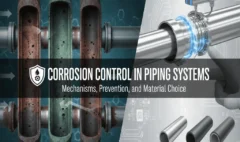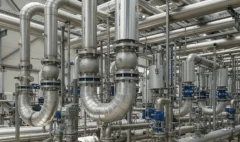Decoding Piping Material Specifications: A Guide to ASTM, ASME, and API Standards 📜
0 comments
Decoding Piping Material Specifications: A Guide to ASTM, ASME, and API Standards 📜
Introduction:
- The critical importance of material specifications in ensuring piping integrity, safety, and performance. The “alphabet soup” of standards.
Why Material Specifications are Essential:
- Define required chemical composition, mechanical properties, manufacturing methods, testing, and tolerances.
- Ensure consistency and quality of materials.
- Provide basis for design calculations (allowable stresses).
- Facilitate procurement and interchangeability.
- Ensure traceability.
Key Standards Organizations and Their Roles in Piping Materials:
- ASTM International (American Society for Testing and Materials):
- Develops and publishes technical standards for materials, products, systems, and services.4
- ASTM specifications define specific material grades (e.g., ASTM A106 for seamless carbon steel pipe, ASTM A312 for seamless stainless steel pipe, ASTM A234 for wrought carbon steel fittings, ASTM A193 for alloy steel bolting).
- Focuses on the “what” – the properties and testing of the material itself.
- ASME (American Society of Mechanical Engineers):
- ASME Boiler and Pressure Vessel Code (BPVC):
- Section II, Part A (Ferrous Material Specifications): Largely adopts ASTM A-prefixed specifications (e.g., SA-106 is ASME’s adoption of ASTM A106).
- Section II, Part B (Nonferrous Material Specifications): Largely adopts ASTM B-prefixed specifications.
- Section II, Part C (Specifications for Welding Rods, Electrodes, and Filler Metals).
- Section II, Part D (Properties):5 Provides allowable stresses, design stress intensities, tensile/yield strength values for various materials at different temperatures. Crucial for design calculations.
- ASME B31 Codes for Pressure Piping (e.g., B31.3 Process Piping, B31.1 Power Piping):
- These codes specify which materials (often referencing ASME SA/SB or ASTM specs) are acceptable for different services and conditions.
- Provide rules for design, fabrication, examination, and testing, often linking material choice to these rules.
- ASME Boiler and Pressure Vessel Code (BPVC):
- API (American Petroleum Institute):
- Develops standards for the oil and gas industry.
- API specifications for line pipe (e.g., API 5L), valves (API 600, API 6D), etc.
- Sometimes API specs have specific requirements beyond or different from ASTM/ASME for oil and gas applications.
- ASTM International (American Society for Testing and Materials):
Understanding Material Designations and What They Mean:
- Example: ASTM A106 Grade B:
- ‘A’ often indicates ferrous material.
- ‘106’ is the sequential number of the standard.
- ‘Grade B’ indicates a specific strength level or chemical composition within that standard.
- Example: ASTM A312 TP304L:
- ‘TP’ often means ‘Type’ for stainless steels (Tubular Product).
- ‘304L’ is a specific type of austenitic stainless steel (L for low carbon).
- Example: ASTM A106 Grade B:
Key Information Found in a Material Specification:
- Scope.
- Referenced documents.
- Ordering information.
- Chemical composition (ranges for elements).
- Mechanical properties (tensile strength, yield strength, elongation, hardness, impact toughness).
- Heat treatment requirements.
- Manufacturing process (e.g., seamless, welded).
- Testing and inspection requirements (hydrostatic test, NDE).
- Dimensions and tolerances.
- Marking and certification requirements.
The Link Between Material Spec and Design Allowable (ASME Section II Part D & B31.3 Appendix A):
- How specified minimum yield and tensile strengths are used to derive allowable stresses.
Conclusion & Call to Action:
- Navigating material specifications is a core skill for piping engineers and designers. Understanding how ASTM, ASME, and API standards interrelate and what information they contain is crucial for selecting appropriate materials and ensuring compliance. Courses that focus on understanding and applying material standards, including how to read Mill Test Reports (MTRs) and relate them back to ASME code requirements (like allowable stresses in B31.3 Appendix A and material properties in Section II Part D), are invaluable.
Related Posts
Search
Categories
Popular Tags
3D CAD
API
ASME
ASME B31.3
ASME B31; Mechanical Completion
ASME Codes and Standards
B31.3 Information
Carbon Steel
Chemical Engineering
ISA
Material Selection
Mechanical Engineering
Oil And Gas
Pipe Stress Analysis
Piping
Piping Codes
Piping Designer
Piping Design Software
Piping Engineer
Piping Engineering
Piping Materials
Piping Stress Analysis Engineering
Project Management
Project Scope
Safety in Piping Systems
SmartPlant 3D
Stainless Steel
Stress Analysis
Training; ASME Courses
Valve Selection
| S | M | T | W | T | F | S |
|---|---|---|---|---|---|---|
| 1 | ||||||
| 2 | 3 | 4 | 5 | 6 | 7 | 8 |
| 9 | 10 | 11 | 12 | 13 | 14 | 15 |
| 16 | 17 | 18 | 19 | 20 | 21 | 22 |
| 23 | 24 | 25 | 26 | 27 | 28 | 29 |
| 30 | ||||||









